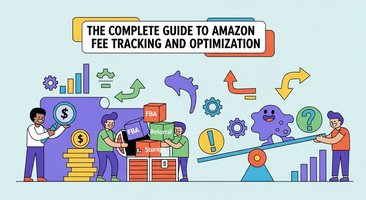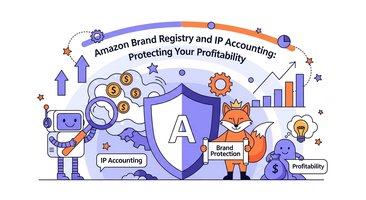Running an Amazon FBA business can be incredibly profitable, but managing the accounting side often feels overwhelming. Between complex fee structures, inventory tracking, and tax compliance, many sellers struggle to maintain accurate financial records. This comprehensive guide will walk you through everything you need to know about FBA accounting and show you how to streamline the process for maximum profitability.
Understanding Amazon FBA Business Model
Fulfillment by Amazon (FBA) fundamentally changes how you handle inventory and customer service. Instead of storing products in your garage or warehouse, Amazon handles storage, picking, packing, and shipping for you. While this creates incredible scalability opportunities, it also introduces unique accounting challenges that traditional bookkeeping methods can't handle effectively.
The key difference between FBA and traditional retail lies in inventory ownership. You own the products sitting in Amazon's warehouses, but you have limited visibility into real-time inventory levels and movements. This creates several accounting complexities:
- Inventory valuation becomes more complex with multiple fee layers
- Cost of goods sold (COGS) calculations must include various Amazon fees
- Cash flow timing differs significantly from traditional retail models
- Tax implications vary based on where your inventory is stored
Amazon FBA Fee Structure Breakdown
Understanding Amazon's fee structure is crucial for accurate profit margin calculations. Amazon charges multiple types of fees that directly impact your bottom line, and each needs proper accounting treatment.
Referral Fees
Amazon's referral fees typically range from 6% to 45% of the item's sale price, depending on the category. Most categories fall between 8-15%. These fees should be recorded as:
- Cost of goods sold for product-related referral fees
- Operating expenses for service-related categories
FBA Fulfillment Fees
FBA fulfillment fees cover picking, packing, and shipping your products. These fees vary based on:
- Product size and weight
- Time of year (peak season surcharges)
- Product category
- Fulfillment speed
These fees should always be included in your cost of goods sold calculations since they're directly tied to product fulfillment.
Storage Fees
Amazon charges monthly storage fees based on the volume of space your inventory occupies. Storage fees include:
- Standard storage fees (lower rates for most of the year)
- Peak season storage fees (higher rates October-December)
- Long-term storage fees for inventory older than 365 days
Storage fees should be allocated across your inventory and included in carrying costs calculations.
Additional FBA Fees
Several other fees can impact your profitability:
- Removal fees for returning unsold inventory
- Disposal fees for destroying unsold products
- Return processing fees for customer returns
- Unplanned service fees for prep work Amazon performs
Setting Up Your FBA Accounting System
Proper chart of accounts setup is essential for accurate FBA accounting. Your accounting system needs to capture the unique aspects of the FBA business model while providing clear visibility into profitability.
Essential Account Categories
Revenue Accounts:
- Amazon FBA Sales
- Amazon FBA Sales - Returns and Refunds
- Amazon FBA Sales - Promotional Adjustments
Cost of Goods Sold:
- Product Costs
- Amazon Referral Fees
- FBA Fulfillment Fees
- Inbound Shipping Costs
- Product Prep Costs
Operating Expenses:
- Amazon Storage Fees
- Amazon Advertising Costs
- Professional Selling Plan Fees
- Inventory Removal/Disposal Fees
Asset Accounts:
- FBA Inventory - Raw Materials
- FBA Inventory - Finished Goods
- FBA Inventory - In Transit
Inventory Valuation Methods
Choosing the right inventory valuation method significantly impacts your financial statements and tax obligations. The three main methods are:
First-In, First-Out (FIFO): Assumes oldest inventory sells first. This method typically results in higher profits during inflationary periods but also higher taxes.
Last-In, First-Out (LIFO): Assumes newest inventory sells first. LIFO can reduce taxable income during inflation but isn't allowed for international operations.
Weighted Average Cost: Calculates average cost across all inventory. This method smooths out price fluctuations and works well for products with consistent costs.
For most FBA sellers, weighted average cost provides the most accurate representation of profitability while simplifying record-keeping.
Managing FBA Cash Flow
Cash flow management in FBA requires understanding Amazon's payment cycles and fee structures. Amazon typically pays sellers every 14 days, but various holds and reserves can impact timing.
Amazon Payment Cycles
Amazon's disbursement schedule affects your cash flow planning:
- Standard disbursement: Every 14 days
- Daily disbursement: Available for established sellers
- Reserve holds: Amazon may hold funds for new sellers or high-risk categories
Accounting for Amazon Reserves
When Amazon holds reserves, you need to account for these funds properly:
- Record sales revenue when the sale occurs
- Create an "Amazon Reserve" asset account for held funds
- Transfer funds from reserves to cash when Amazon releases them
This approach ensures your profit and loss statements accurately reflect business performance regardless of Amazon's payment timing.
Tax Considerations for FBA Sellers
FBA tax compliance involves multiple jurisdictions and complex regulations. Amazon's fulfillment network creates tax obligations in states where you might not have a physical presence.
Sales Tax Nexus
Amazon's FBA inventory storage creates sales tax nexus in multiple states. Key considerations include:
- Physical nexus: Created by storing inventory in Amazon warehouses
- Economic nexus: Triggered by sales volume or transaction thresholds
- Marketplace facilitator laws: Amazon may collect and remit sales tax on your behalf
Income Tax Planning
Proper income tax planning requires accurate profit calculations throughout the year:
- Track profitability by product and channel
- Plan for quarterly estimated tax payments
- Maximize deductions for business expenses
- Consider tax implications of inventory valuation methods
Automating FBA Accounting with Technology
Manual FBA bookkeeping becomes overwhelming as your business grows. Modern accounting automation tools can handle the complexity while providing real-time insights into your business performance.
Klavena specializes in ecommerce accounting automation and offers specific features for Amazon FBA sellers:
- Automated transaction categorization for all Amazon fee types
- Real-time inventory tracking with cost basis calculations
- Multi-marketplace support for sellers operating internationally
- Automated sales tax compliance across multiple jurisdictions
- Integrated financial reporting with FBA-specific metrics
Key Automation Benefits
Time Savings: Automated categorization eliminates hours of manual data entry and reduces the risk of errors in your financial records.
Accuracy Improvements: Automated systems consistently apply accounting rules and catch discrepancies that manual processes might miss.
Real-Time Insights: Access up-to-date profitability data to make informed business decisions about inventory, pricing, and expansion.
Scalability: Automated systems handle increased transaction volume without proportional increases in accounting workload.
Best Practices for FBA Accounting Success
Implementing these best practices will help ensure accurate financial records and better business decision-making:
Monthly Reconciliation Process
- Reconcile Amazon settlement reports with accounting records
- Verify inventory levels against Amazon's reporting
- Review and categorize any unmatched transactions
- Analyze profitability trends and identify areas for improvement
Documentation and Record Keeping
- Maintain detailed records of all product costs and fees
- Document inventory purchases and movements
- Keep receipts for all business-related expenses
- Store records electronically with proper backup systems
Performance Monitoring
- Track key performance indicators (KPIs) specific to FBA:
- Gross margin by product
- Inventory turnover rates
- Storage cost per unit
- Return rates and associated costs
Professional Support
Consider working with accounting professionals who understand ecommerce accounting complexities:
- CPA with ecommerce experience for tax planning
- Bookkeeper familiar with Amazon's fee structures
- Technology consultant for accounting system implementation
Common FBA Accounting Mistakes to Avoid
Understanding these common mistakes can save you significant time and money:
Mistake #1: Not tracking inventory properly
Many sellers fail to maintain accurate inventory records, leading to incorrect COGS calculations and tax issues.
Mistake #2: Misclassifying Amazon fees
Incorrectly categorizing referral fees as operating expenses instead of COGS distorts profit margins.
Mistake #3: Ignoring sales tax obligations
Failing to understand nexus rules can result in significant penalties and back-tax liabilities.
Mistake #4: Poor cash flow management
Not accounting for Amazon's payment cycles and reserves can create cash flow problems.
Mistake #5: Manual processes that don't scale
Relying on spreadsheets and manual data entry becomes unsustainable as businesses grow.
Preparing for Growth and Scale
As your FBA business grows, your accounting needs become more complex. Planning for scale from the beginning helps avoid costly transitions later.
Scaling Considerations
- Multi-marketplace expansion requires currency and tax handling
- Product line diversification needs detailed profitability tracking
- Team growth demands better financial controls and reporting
- Investor relations require professional-grade financial statements
Technology Investment
Investing in proper accounting automation early provides several advantages:
- Easier expansion into new marketplaces
- Better data for business decision-making
- Reduced risk of compliance issues
- More attractive business metrics for potential investors or buyers
Conclusion
Amazon FBA accounting doesn't have to be overwhelming. With proper setup, the right technology, and consistent processes, you can maintain accurate financial records while focusing on growing your business.
The key is understanding Amazon's unique fee structures, implementing proper inventory tracking, and using automation to handle the complexity. Whether you're just starting with FBA or looking to optimize your existing processes, investing in proper accounting systems will pay dividends in better decision-making and improved profitability.
Remember that accurate accounting is not just about tax compliance—it's about understanding your business well enough to make informed decisions about pricing, inventory, and growth opportunities. With the right foundation in place, you can scale your FBA business confidently while maintaining clear visibility into your financial performance.
For sellers ready to automate their FBA accounting, Klavena offers specialized features designed specifically for Amazon sellers, including automated fee categorization, real-time inventory tracking, and comprehensive financial reporting tailored to the unique needs of FBA businesses.





